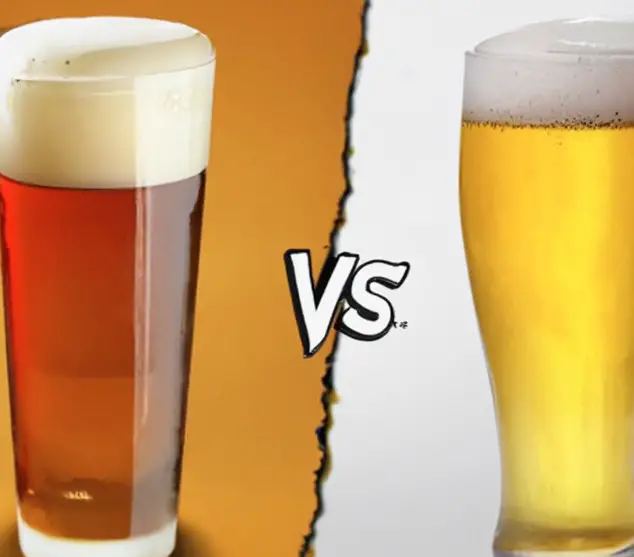As an expert brewer, I’ve had the pleasure of experimenting with countless beer styles and brewing techniques. Two styles that can be somewhat confusing, especially for those new to the craft beer world, are golden ale and blonde ale.
While they may seem very similar, there are subtle differences that set them apart, making each a unique and enjoyable experience for the beer enthusiast.
The main difference between golden ale and blonde ale is that golden ales tend to be slightly more hop-forward, with a slightly higher alcohol content and a fuller body, while blonde ales are generally lighter in both flavor and body, with a more balanced malt and hop profile.
In this blog post, I’ll explore the distinctions between these two styles, delving into their origins, appearance, aroma, taste, and brewing process.
So, let’s dive in and uncover the differences between golden ale and blonde ale!
1. Origins and History
Golden Ale and Blonde Ale are two popular beer styles that share some similarities but also have their unique characteristics. Both are relatively new beer styles compared to traditional ales, but their origins can be traced back to different parts of the world.
Golden Ale has its roots in England, while Blonde Ale originated in Belgium. In this section, we will delve into the history and evolution of these two beer styles and explore how they came to be what they are today.
Golden Ale:
- Golden ales originated in the United Kingdom, where they were first brewed in the 1980s as a response to the growing popularity of lighter lagers.
- The style was intended to offer a flavorful alternative to mass-produced lagers while remaining approachable for a wide range of beer drinkers.
- Golden ales have since become a popular choice in the UK and beyond, with many breweries crafting their own unique interpretations of the style.
Blonde Ale:
- Blonde ales, on the other hand, have their roots in North America, where they were first brewed in the early 20th century.
- This style was initially created as a way for American and Canadian brewers to showcase local ingredients and offer a more flavorful alternative to the light lagers that dominated the market at the time.
- Blonde ales have since become a staple in the craft beer scene, with countless breweries producing their own variations on this classic style.
2. Appearance
Appearance is a crucial aspect of beer that can influence our perceptions and expectations before even taking the first sip.
Golden ales and blonde ales are two popular beer styles that are often mistaken for one another due to their similar color.

However, upon closer inspection, there are noticeable differences in their appearance that can help beer enthusiasts distinguish between the two styles. In this section, we’ll explore the visual characteristics of golden ales and blonde ales and highlight what sets them apart.
Golden Ale:
- As the name suggests, golden ales are characterized by their bright, golden color, which can range from a pale straw hue to a deeper amber shade.
- The beer often has a slight haze, although it can also be crystal clear, depending on the brewing process and ingredients used.
- Golden ales typically have a moderate to high level of carbonation, resulting in a frothy, white head that can leave some lacing on the glass as it dissipates.
Blonde Ale:
- Blonde ales are generally lighter in color than golden ales, with a pale yellow to golden hue.
- The clarity of a blonde ale can also vary, from slightly hazy to brilliantly clear.
- Like golden ales, blonde ales tend to have a moderate to high level of carbonation, with a fluffy, white head that may leave lacing on the glass.
3. Aroma
Aroma plays a crucial role in the drinking experience of beer, as it can greatly affect the flavor and overall enjoyment of the beverage. When it comes to golden ale and blonde ale, the aroma profile can vary greatly, with each style having its unique characteristics that set it apart from the other. In this section, we will explore the aroma of both golden ale and blonde ale and delve into what makes them distinct from one another.
Golden Ale:
- The aroma of a golden ale is often dominated by the hops, which can lend a range of fruity, floral, or spicy notes to the beer.
- Malt aromas are usually present but more subdued, offering a subtle sweetness that complements the hop character.
- Some golden ales may also exhibit a slight yeast-derived fruitiness or esters, particularly if they have been brewed with an English ale yeast strain.
Blonde Ale:
- In contrast, the aroma of a blonde ale is typically more balanced between malt and hop notes.
- The malt character often comes through as a light, bready or grainy sweetness, while the hops contribute a gentle floral or citrus aroma.
- Blonde ales generally have a cleaner fermentation profile than golden ales, with fewer yeast-derived esters and a more neutral overall aroma.
4. Taste
When it comes to beer, taste is king. Each type of beer has its own unique flavor profile, and this is especially true for golden ale and blonde ale. Both beers are known for their light and refreshing taste, but there are distinct differences between the two. In this section, we’ll explore the taste of golden ale and blonde ale and what sets them apart.
Golden Ale:
- The taste of a golden ale is characterized by a slightly more assertive hop profile than a blonde ale, with flavors ranging from citrus and tropical fruit to floral or spicy.
- The malt backbone provides a supporting role, adding a touch of sweetness and body to the beer without overpowering the hops.
- Golden ales often finish with a moderate to strong bitterness, which can linger on the palate and encourage another sip.
Blonde Ale:
- The flavor of a blonde ale is generally more balanced and approachable, with a lighter hop presence that allows the malt character to shine through.
- The malt flavors in a blonde ale may include notes of bread, crackers, or light caramel, while the hops contribute a mild bitterness and subtle fruity or floral notes.
- Blonde ales typically finish with a clean, crisp, and refreshing quality, making them an easy-drinking option for a variety of occasions.
5. Mouthfeel
Mouthfeel is an essential aspect of beer that can make or break the drinking experience. When it comes to golden ale and blonde ale, the mouthfeel can be quite different, even though the two styles are often confused. In this section, we’ll explore how the mouthfeel of these two beers can affect their overall flavor and enjoyment.
Golden Ale:
- Golden ales usually have a medium body, with a slightly fuller and richer mouthfeel than a blonde ale.
- The higher carbonation level can lend a lively, effervescent quality to the beer, which can enhance the perceived bitterness and hop character.
- Some golden ales may also have a slight creaminess or smoothness, particularly if they have been brewed with a high proportion of malted wheat or oats.
Blonde Ale:
- The mouthfeel of a blonde ale is generally lighter and more delicate than that of a golden ale, with a crisp, clean, and refreshing quality.
- The carbonation level is typically moderate to high, which can create a lively and spritzy sensation on the tongue.
- Blonde ales are usually easy-drinking and quaffable, making them a popular choice for warm weather or social occasions.
6. Alcohol Content
Golden Ale:
- The alcohol content of a golden ale can vary, but it generally falls within the range of 4.5-6% ABV.
- This slightly higher alcohol content can contribute to the fuller body and more assertive flavors found in golden ales, setting them apart from the more sessionable blonde ales.
Blonde Ale:
- Blonde ales are typically lower in alcohol, with an average ABV of 3.8-5.5%.
- The lower alcohol content of blonde ales makes them an ideal choice for those looking for a lighter, more sessionable beer option.
7. Brewing Process
The brewing process is the heart of every beer. It is the art of transforming raw ingredients into a refreshing beverage that tantalizes the senses.
For both golden ale and blonde ale, the brewing process plays a critical role in creating their unique flavors, aromas, and appearance. In this section, we will take a closer look at the brewing process for these two popular beer styles and explore how each step contributes to their distinctive characteristics.
Golden Ale:
- The brewing process for a golden ale may involve a higher proportion of specialty malts, such as Vienna or Munich, which can contribute to the beer’s distinctive color and fuller body.
- Golden ales often incorporate a blend of hop varieties, with the focus on creating a more hop-forward flavor profile.
- English ale yeast strains are commonly used in golden ales, which can impart a slight fruitiness or ester character to the beer.
Blonde Ale:
- Brewing a blonde ale typically involves a simpler malt bill, with a focus on pale or Pilsner malts that create a light, clean malt backbone.
- The hop profile in a blonde ale is usually more restrained, with a focus on creating a balanced and approachable flavor profile.
- American or neutral ale yeast strains are often used in blonde ales, resulting in a cleaner fermentation profile and more subtle overall character.
8. Food Pairings
When it comes to beer, choosing the right food pairing can make all the difference in the world. The right combination can elevate both the taste of the beer and the food, creating a harmonious and enjoyable experience.
In this section, we’ll explore some of the best food pairings for two popular beer styles: Golden Ale and Blonde Ale. Whether you’re a seasoned beer enthusiast or a curious beginner, these suggestions will help you discover new flavors and enhance your enjoyment of these delicious brews.
Golden Ale:
- The slightly more assertive flavors and fuller body of a golden ale make it an excellent pairing for a variety of dishes.
- Golden ales pair well with grilled meats, spicy dishes, and hearty salads, as the hop bitterness can help to cut through and balance the flavors.
- The fruity, floral, or spicy hop notes in a golden ale can also complement the flavors in dishes featuring citrus, herbs, or bold spices.
Blonde Ale:
- The lighter, more balanced character of a blonde ale makes it a versatile option for a wide range of food pairings.
- Blonde ales work well with lighter fare, such as salads, seafood, and poultry, as the delicate flavors in the beer won’t overwhelm the dish.
- The clean, crisp finish of a blonde ale also makes it a great choice for pairing with creamy or rich dishes, as it can help to cleanse the palate and refresh the taste buds between bites.
9. Popular Examples
When it comes to beer, Golden Ales and Blonde Ales are two of the most popular styles out there. With their light and refreshing profiles, these beers are perfect for casual drinking and outdoor gatherings. In this section, we’ll take a closer look at some of the most popular examples of these two styles and what makes them stand out from the rest.
Golden Ale:
- Fuller’s Summer Ale (UK)
- Boddingtons Pub Ale (UK)
- Goose Island Honkers Ale (USA)
Blonde Ale:
- Kona Big Wave Golden Ale (USA)
- Firestone Walker 805 Blonde Ale (USA)
- New Belgium Brewing Company’s Dayblazer Easygoing Ale (USA)
Conclusion
In conclusion, while golden ale and blonde ale may appear similar at first glance, there are subtle differences between these two beer styles that set them apart. To recap, here are 10 key distinctions between golden ale and blonde ale:
1. Golden ales originated in the UK, while blonde ales have their roots in North America.
2. Golden ales are generally darker in color than blonde ales.
3. The aroma of a golden ale is often more hop-forward, while the aroma of a blonde ale is more balanced between malt and hop notes.
4. Golden ales have a slightly more assertive hop profile in terms of taste, while blonde ales are more balanced and approachable.
5. Golden ales typically have a fuller body and mouthfeel compared to blonde ales.
6. The alcohol content of golden ales is usually slightly higher than that of blonde ales.
7. The brewing process for golden ales may involve a higher proportion of specialty malts and a more hop-forward approach, while blonde ales focus on a simpler malt bill and a more restrained hop profile.
8. Golden ales pair well with grilled meats, spicy dishes, and hearty salads, while blonde ales are more versatile in terms of food pairings.
9. Popular examples of golden ales include Fuller’s Summer Ale and Goose Island Honkers Ale, while popular examples of blonde ales include Kona Big Wave Golden Ale and Firestone Walker 805 Blonde Ale.
10. The main difference between golden ale and blonde ale is that golden ales tend to be slightly more hop-forward, with a slightly higher alcohol content and a fuller body, while blonde ales are generally lighter in both flavor and body, with a more balanced malt and hop profile.
FAQs
Is a golden ale a lager?
No, a golden ale is not a lager. It is an ale, which means it is brewed with a top-fermenting yeast at warmer temperatures than lagers, which are brewed with a bottom-fermenting yeast at cooler temperatures.
What makes a blonde ale a blonde ale?
Blonde ale is a light-colored, easy-drinking beer that is characterized by its mild malt flavor, low bitterness, and crisp finish. It is typically brewed with a combination of pale malt and a small amount of specialty malt, and is often hopped with noble hops for a subtle, floral aroma. Blonde ales are known for their balance and drinkability, making them a popular choice for a wide range of beer drinkers.
What is a golden ale?
A golden ale is a type of beer that is typically light to medium-bodied, has a pale golden color, and a moderate to high level of carbonation. It is brewed with a combination of pale malt and sometimes other specialty malts, which give it a slightly sweet, biscuity flavor. The hops used in golden ales are typically mild and floral, contributing to a balanced bitterness and aroma. Overall, golden ales are refreshing and easy-drinking, making them a popular choice among beer drinkers.
What makes it a golden ale?
Golden ale is a style of beer that is typically light in color, low in bitterness, and has a moderate to high level of carbonation. It is brewed with pale malts and often features fruity or floral hop flavors. The name “golden” refers to its color, which is typically a bright golden hue.
What is the difference between ale and blonde ale?
Ale is a broad category of beer that includes many different styles, while blonde ale is a specific style of ale that is typically light in color and mild in flavor. Blonde ales are often brewed with pale malt and may have a slightly sweet or fruity taste, whereas other types of ale can vary widely in flavor and color depending on the specific style.
What is a blonde ale?
Blonde ale is a type of beer that is light in color, low in bitterness, and has a subtle malt flavor. It is typically brewed with pale malt and may have a slightly sweet taste. Blonde ales are often described as easy-drinking and refreshing.




